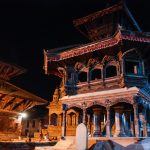Nepal has a rich and diverse cultural heritage where performing arts have always played a vital role in expressing the social, religious, and historical narratives of its people. Theater, as a form of performing art, has evolved from ancient ritualistic and folk performances tied closely to festivals and religious ceremonies into a modern and dynamic cultural expression. Today, Nepal’s theater scene blends traditional storytelling, classical dance-dramas, and contemporary experimental plays, reflecting the country’s complex social fabric and aspirations. This article explores the history of performing arts in Nepal, the rise of modern theater, and highlights some of the most prominent live theaters operating in Kathmandu.
Historical Background of Performing Arts in Nepal
The roots of performing arts in Nepal can be traced back to ancient religious and folk traditions. Long before the arrival of formal proscenium stages and scripted plays, communities expressed stories through ritual dances, masked performances, and street plays. In Kathmandu Valley, dance-dramas like Harisiddhi Naach and Kartik Naach were performed in temples during specific festivals and religious occasions. These performances involved elaborate costumes, music, and stylized movements that depicted Hindu and Buddhist mythologies. The Lakhey dance, a vibrant masked dance performed during the Indra Jatra festival, and the comedic and satirical performances of the Gaijatra festival are also prominent examples of ritual theater that are still alive today. These traditions were preserved and patronized especially during the Malla era (12th to 18th centuries), when kings encouraged arts and culture, supporting the performance of dramas in Sanskrit and Newar languages. The art forms combined storytelling, music, dance, and religious symbolism to educate and entertain communities.
Transition to Modern Theatre in Nepal
Moving beyond religious and folk origins, Nepal’s theater culture transitioned during the 20th century with the influence of Indian and Western theatrical traditions. Exposure to Hindi, Urdu, and Bengali theater, brought by cultural exchanges and migration, introduced the proscenium stage, scripted dialogues, and modern acting techniques. This period saw the emergence of written plays focusing on social and political issues. The Panchayat era (1960–1990) was particularly important for theater as it became a subtle form of political protest and social awareness despite strict censorship. Playwrights like Govinda Gothale and Balkrishna Sama became influential voices, addressing themes of social justice, inequality, and nationalism. During this time, theater was also used as a tool for education and activism, especially through street plays known as Sadak Natak and Forum Theatre. These forms were designed to engage the general public on issues such as caste discrimination, gender inequality, and human rights, making theater accessible outside formal venues.
Contemporary Theatre Scene in Nepal
Today, Nepal’s contemporary theater scene is vibrant and diverse, mixing traditional styles with modern narratives and experimental methods. Performances are often multilingual, including Nepali, Newar, English, and regional languages, reflecting the country’s multicultural identity. Themes tackled in modern theater range from social justice and migration to urbanization and gender roles. Directors and playwrights such as Sunil Pokharel, Anup Baral, Ashesh Malla, and Nisha Sharma have been pivotal in revitalizing Nepali theater by introducing new storytelling techniques and fostering a creative environment for artists. Experimental theater companies focus on minimalism, physical acting, and breaking conventional narrative forms to engage audiences differently. This contemporary spirit coexists with traditional festivals and performance arts, enriching Nepal’s cultural landscape.
Major Live Theaters in Kathmandu
Kathmandu, as the cultural heart of Nepal, hosts several key live theaters that serve as important platforms for both traditional and modern performances.
Gurukul Theatre in Purano Baneshwor is renowned for its contribution to modern Nepali theater. Founded by Sunil Pokharel, who is considered the father of Nepali theater, Gurukul offers acting classes and stages innovative plays that blend classical and contemporary techniques.
Shilpee Theatre in Battisputali focuses on socially conscious productions and trains young artists, making it a hub for activism through performance.
Mandala Theatre in Thapagaun is a community-driven space emphasizing participation and experimentation. It regularly hosts festivals and workshops that promote new voices in Nepali theater.
Theatre Village in Lazimpat is known for its fusion of traditional Nepali and global performance styles, providing a platform for diverse cultural expressions.
The National Theatre in Jamal, run by the government, stages large productions and classical arts, serving as an important venue for national cultural events.
One World Theatre specializes in international collaborations and English-language plays, attracting a cosmopolitan audience.
Kausi Theatre in Teku is a small, intimate black box theater known for its experimental and minimalist performances, offering an alternative to mainstream productions.
Challenges and Opportunities
Despite its rich heritage and vibrant contemporary scene, Nepalese theater faces several challenges. Limited funding and infrastructure restrict the ability of artists and companies to reach wider audiences. Most theaters are concentrated in Kathmandu, leaving rural areas underserved. Language barriers can limit accessibility, as some performances are in Newar or other regional dialects. However, the rise of digital platforms and social media offers new opportunities for outreach and creative expression. Schools, NGOs, and urban youth groups play a critical role in nurturing theater culture by organizing workshops, festivals, and community performances. The theater scene in Nepal remains resilient, continually adapting to changing social contexts while honoring its deep traditional roots.
Conclusion
Theater culture in Nepal is a living testament to the country’s layered history and cultural diversity. From the ritual dance-dramas performed in ancient temples to the socially conscious street plays and innovative stage productions of today, theater continues to mirror Nepali society’s evolving stories and struggles. The live theaters of Kathmandu provide vital spaces for artists to connect with audiences and keep this art form vibrant. As Nepal moves forward, preserving and promoting its theatrical heritage alongside modern experimentation will be essential for sustaining a culturally rich and socially engaged performing arts scene.

